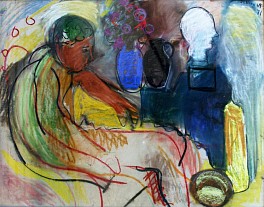BIOGRAPHY

American, 1922-1993
Bridging the gap between European Modernism and Abstract Expressionism, Robert De Niro, Sr. (1922-1993) deftly blended abstraction and representation, cleverly referencing European masters from Delacroix to Matisse. He participated in the seminal 9th Street Show in 1951, which introduced the New York School and Abstract Expressionism to the world.
A review in the New York Times described his work thusly:
"Coming of age in the late 1940s, Mr. De Niro was committed to a kind of figurative painting indebted mainly to Matisse. He favored routine, School of Paris-type subject matter: generalized portraits, still lifes, the female nude and room interiors. But he painted with sensuous panache and an acute feel for color, using wide, generously loaded brushes. While the things he pictured were usually static, the way he rendered them — in a fluid choreography of painterly gestures and in hues ranging from muddy to incandescent — makes them seem voluptuously alive. . . [His] seemingly effortless paintings . . . register states of sensory grace."
In the late 1930s and early 1940s, De Niro studied with both Hans Hofmann in New York and Provincetown and then with Josef Albers at the reknowned Black Mountain College in Asheville, North Carolina. As well, during this time, De Niro worked for Hilla Rebay’s legendary Museum of Non-Objective Art, the foundation of Solomon Guggenheim's Museum. In 1945, he was included in a group show at Peggy Guggenheim’s Art of This Century in New York and the following spring had his first solo exhibition with the gallery. Beginning in 1950, De Niro had a series of exhibitions at the Charles Egan Gallery in New York, which also showed the work of Willem de Kooning, Franz Kline, Philip Guston, and exhibited works in the Whitney Museum Annuals, Stable Gallery Annuals, and the Jewish Museum’s celebrated 1957 show, "Artists of the New York School: Second Generation."
De Niro 's type of painting fell somewhat out of favor with the advent not just of Abstract Expressionism, but also Minimalism and Colorfield painting. Although it is true that his subject matter and use of color owed much to the European Modernists, especially Matisse and Bonnard, his handling of paint and his technique owed much to the Abstract Expressionists. A reviewer for the New York Times put it this way upon his death: "His images, while legible, relied on a highly abstract repertory of quick dabs, thick swaths, and thin washes of paint."
Robert De Niro, Sr.'s work is in the collections of numerous institutions including the Metropolitan Museum of Art, NY, Brooklyn Museum, NY, Smithsonian American Art Museum, Washington, DC, Hirshhorn Museum and Sculpture Garden, Washington, DC, Corcoran Gallery of Art, Washington, DC and Whitney Museum of American Art, New York.
